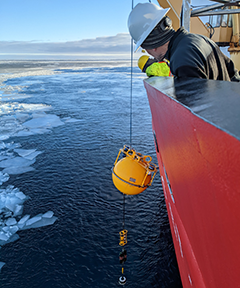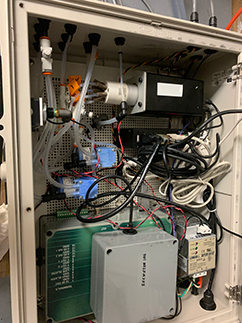Ashley Arroyo
October 10, 2022
Carbon dioxide (CO2) is an important greenhouse gas, which traps and re-emits heat in the Earth’s atmosphere. The oceans are a significant carbon sink; the amount of CO2 in the Earth’s atmosphere is of comparable magnitude to that absorbed by the ocean. Since colder surface waters can absorb more CO2 than warmer waters, the Arctic Ocean plays an important role in global CO2 uptake. Understanding how CO2 is evolving in the Arctic Ocean is particularly relevant because of sea-ice decline; decreasing sea ice concentrations lead to the potential for increased air-sea gas exchange, which could alter carbon cycling and storage on local and global scales. For these reasons, it is very important to monitor CO2 storage and air-sea fluxes in the Arctic Ocean.
Mike DeGrandpre is a professor in the chemistry department at the University of Montana, who is aboard the Louis taking measurements of pCO2 (the partial pressure of CO2 in a liquid or a gas) in the surface waters of the Canada Basin. On a day-to-day basis, Mike has been using an “underway system” which takes near-continuous measurements of pCO2 of seawater from underneath the ship at a depth of 9 meters. Seawater is brought through stainless steel tubing into the ship’s main lab where it runs through an equilibrator. Within the equilibrator, a small volume of air from the lab interacts with the seawater, causing the pCO2 of the air to “equilibrate,”5: or become the same as the pCO2 in the seawater. The equilibrated air is then sent into an infrared gas analyzer, which determines the pCO2 of the air (which is the same as the pCO2 of the sea water). The underway system produces a continuous record of pCO2 throughout the entire expedition. Combining this data set with other measured parameters (i.e., atmospheric pCO2, water temperature, sea ice concentration, wind speed, etc.), the air-sea flux of CO2 into the Arctic Ocean can be computed.
In addition to the data that are recorded through the ships underway pCO2 system, Mike along with the science crew from Woods Hole Oceanographic Institution (WHOI) have installed Submersible Autonomous Moored Instruments (SAMI-CO2) on the Ice Tethered Profilers and moorings that have been deployed as a part of this year’s expedition. The SAMI-CO2 sensors take measurements of pCO2 at fixed depths on the instruments: the sensors are located at depths of 4 meters on the ITPs and 40 meters on the moorings. The data that will be produced from the SAMI-CO2 sensors will be valuable in quantifying pCO2 in Arctic Ocean surface waters to help us gain insight on carbon cycling and air-sea fluxes of CO2 in the Arctic Ocean under a warming climate.

